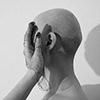

SIMON: Benny finds something, a kind of solace, a kind of understanding, at the library, which is capitalized in the book. He needs help from a different kind of community of people.

On the other hand, the kind of help Benny needs is not really that. Certainly, it's good that she's there and is tracking him. But I think that ultimately - perhaps it helps him a little bit. She has been schooled in a certain diagnostic practice, and so she really tries to help him. I mean, his therapist is - you know, his psychiatrist is very well-intentioned. He gets professional help, and it's - I don't want to give anything away - maybe not of much help. But I have had this other experience, too. And I explained that no, no, my voices, the fictional voices that I hear, are more internal. And meanwhile, I'm writing books, and I'm, you know - when I talk about this process, the process of writing fiction, I talk about it and say that characters come to me as voices, right? And one reader at an event asked me, do you mean that literally? And it turns out that this reader's son heard voices as though externally with his ear and found it very disturbing. And then I kind of forgot about it for a long time. That happened for about a year after he died.

In a sense, is that where this novel begins? So it was experiencing the loss and the grief all over again. And I'd whip around, and he wouldn't be there.

And behind me, just to the right, I would hear him clear his throat and call my name. And, you know, I'd be doing something random like washing the dishes or folding the laundry. And I certainly did, too, after my dad died. OZEKI: People after a grievous loss start to hear things sometimes. It's tempting to call that just a grief reaction, isn't it? SIMON: Young boy loses his father, starts hearing things talk. Ruth Ozeki, the novelist and filmmaker who also teaches creative writing at Smith College, joins us now from Massachusetts. Can you hear the wood whisper? The ghost of the pine? The mutter of lead? Just hold it next to your head and listen. And they're safe as long as you don't stick the point in your ear. If there's people around, they'll think you're mad. Or take off your shoe and hold it to your ear. Still can't hear? Then get down on your knees and put your head to the seat. So try something more challenging - the chair you're sitting on, the pencil in your pocket, the sneaker on your foot. And obviously, the book is speaking to you. You can start by using your eyes because eyes are easy. But if your ears aren't attuned, you have to learn to listen. Can you hear it? It's OK if you can't though. As Ruth Ozeki writes near the opening of her new novel, "The Book Of Form And Emptiness," books are especially talkative. Things have spoken to him since he was 13 and his father died.


 0 kommentar(er)
0 kommentar(er)
